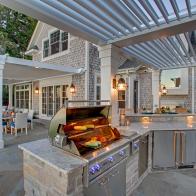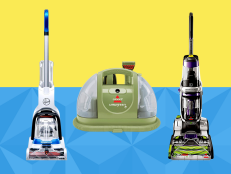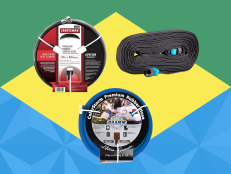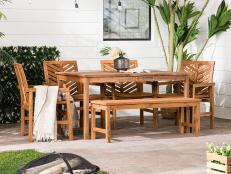How to Get Rid of Termites
Find out what professional exterminators and entomologists say about getting rid of termites and how to prevent them from attacking your home.


Chase D'animulls
Subterranean termite worker. Three types of termites feast on homes in the US: subterranean termites, drywood termites and dampwood termites. With colonies that can number millions of members, subterranean termites cause the most damage of the three.
What Are Termites
Termites are elusive wood-eating insects that can cause costly damage to your home. Believe it or not, these critters are actually a valuable part of our ecosystem. They are a food source for other animals, their tunneling is good for the soil and their feeding habits are hugely important for wood decomposition. This latter activity is where the human world and the termite world collide: You see the difference between a tree stump and your deck supports, but wood is wood to a termite.
Termite Life Cycle and Behavior
Termites have three stages of development — egg, nymph and adult — and are social insects. This means they live in colonies with a division of labor. The termite family unit includes a queen and king to propagate, some soldiers to defend the colony and a bunch of workers to gather food, take care of the young and build the nest and tunnels. Reproductives are sexual adults created when the colony reaches maturity, and those made by the queen and king (called alates or swarmers) will leave the nest. A mature colony can have anywhere from thousands to a million individuals!
Types of Termites
According to pest control company Orkin, there are 45 termite species of termites. But for any given home there will only be a few problematic species to worry about, of three primary types:
- Formosan subterranean termites live in soil creating a mazework of tubes from their underground nests to food sources, which, in the worst case, is the wood in our homes. Their colonies are the largest of any insect and this type of termite causes most of the damage to homes. Subterranean termites are an invasive species wreaking havoc on the Southeastern US with colonies many times larger than those of our native termites. They will build their nests within a home if there’s a source of moisture.
- Dry-wood termites don’t require soil because they build their nests on-site in sound structural lumber, particularly in roofs and attics. Their colonies aren’t as large as subterranean termites, but it’s not uncommon for homes to have multiple small infestations.
- Dampwood termites require wet living conditions and the moisture content in our structural timber is usually too low for them. They will plague homes with water-damaged wood, but their territory is limited. Simply fixing a home’s moisture issue can eradicate a damp-wood termite infestation, so much of our discussion here will center on the other two types.

Shutterstock/SomprasongWittayanupakorn
Subterranean termite soldier. Termites are social insects, living in colonies with a division of labor. The termite family unit includes a queen and king; soldiers (pictured) to defend the colony; and workers to gather food, clean and build the nest. Sexual adults are created when the colony reaches maturity, and those made by the queen and king (called alates or swarmers) have wings and will leave the nest.
What Do Termites Look Like?
A termite’s appearance is based on type and its role in the colony. Size-wise, dampwood termites are the largest and subterranean termites the smallest. Workers look a little like a grain of rice with legs, and soldiers are larger with darker heads and oversized mandibles like pincher beetles. We don’t often see these termites in our houses because their activities are limited to nests and tunnels. What we may witness is the winged swarmers leaving the nest, usually during warm weather after a rain. The termites that aren’t devoured by delighted dragonflies and birds in the area will pair up, drop their wings and get busy (ahem) trying to start their own colony together.
How Do You Know if You Have Termites?
Some homeowners will discover a termite infestation because of a swarm inside the home or against the house outside. If you miss it, you may still find evidence of the swarm in the form of dead swarmers or dropped wings. That said, frequently we find out we have termites not because we see them, but because their activity leaves an evidence trail.
Signs of a Termite Infestation
- Shelter tubes: Subterranean termites build their nests underground and require high humidity, so when they run into a non-chewable surface (e.g., concrete or metal) on the way to a food source, they traverse it by building pencil-width shelter tubes (aka mud tubes) for protection.
- Fecal pellets: Drywood termites build their nests within the wood they feed on and will push fecal pellets out through little kick-out holes. These pellets have a unique hexagonal shape — with six flattened sides.
- Surface irregularities in the home: Hidden termite damage can manifest outwardly as swollen areas in floors and ceilings or, conversely, buckling wood. Termite tunnels that are close to the surface can give wood a blistered appearance.
Commonly, we need to do an investigation beyond the visual. Wood eaten by termites will sound hollow when you knock on it with the back of a screwdriver. Push on the wood with your finger or turn the screwdriver around and dig a bit and it will be easily compromised. From there, you may be looking at eviscerated wood, fecal pellets or the termites themselves.

Shutterstock/4691
Subterranean termite shelter (mud) tubes on a foundation wall. Native subterranean termite build their nests underground with a network of tunnels to food sources. Workers construct pencil-width protective mud tubes to travel across concrete, brick and metal. Finding these tubes on a home’s foundation is evidence that termites are (or have been) present.
How to Conduct a Termite Inspection
Dan Suiter, Orkin distinguished professor in urban entomology at the University of Georgia (UGA), recommends that homeowners inspect their homes once a year, during the warmest part of the year. The Southeast is considered the termite belt of the US because of its welcoming climate, and both subterranean and dry-wood termites are problems for homeowners.
- For subterranean termites, start at the foundation and look for mud tunnels. “If you’re on a crawlspace, grab a flashlight and get down in there,” says Suiter. “Pay close attention to every place that concrete meets wood and any areas of moisture.” He adds that the dirt-filled area under a raised porch attached to the house is a common hotspot. For homeowners with slab construction, Suiter recommends focusing on the exterior walls because that’s commonly the point of entry unless there’s a foundation crack in the slab. Subterranean termites may also gain entry where pipes penetrate the slab.
- For drywood termite infestations, grab the ladder instead, because Suiter says many infestations are in the attic and beams in the upper portions of the home. “Fecal pellets are the big thing you’re looking for here,” he explains. Look for these on framing members and on top of insulation. Suiter explains that we’re far less likely to see wings or dead swarmers with the dry-wood species because their colonies (and therefore swarms) are much smaller than those of subterranean termites.

Shutterstock/gunawand3570
Drywood termite worker with unique hexagonal pellets. Drywood termites build their nests within the wood they feed on and will push fecal pellets out through little holes. The pellets’ unique shape — with six flattened sides — make them easy to distinguish from pellets of other wood-destroying insects.
Differentiating Termites From Other Wood-Destroying Pests
Termites aren’t the only type of insect that will chew on wood. Here’s how to tell the difference between termite activity and that of other wood-destroying pests.
- Carpenter ant wood damage is super clean and smooth, unlike the soil-lined galleries of subterranean termites. Ant pellets left outside won’t have the hexagonal shape like dry-wood termites and there will be ant parts mixed in.
- Woodboring beetles leave small-diameter holes in the wood surface like dry-wood termites, but the sawdust (frass) they push out is often powdery wood debris or, when pellets, won’t have the unique shape.
Treating Termite Infestations: DIY Methods
Chemical treatments available for DIY applications are many of the same termiticides (insecticide products) that professionals use, including:
- Bait systems that use evenly spaced cylindrical stations installed in the soil to feed foraging subterranean termites a slow-acting termiticide that they take back to the nest.
- Liquid termiticide is sprayed on an infestation spot and/or liberally applied to the soil around the foundation perimeter to battle subterranean termites.
- Termiticide foam is injected into wall cavities to battle subterranean and dry-wood infestations.
Natural and Organic Remedies for Termite Control
- Sprays and dusts — boric acid or orange oil products that can be sprayed on active infestations and/or used as barriers.
- Diatomaceous earth (DE) — tiny, fossilized algae that dehydrate the subterranean and dry-wood termites it touches.
- Beneficial nematodes — microscopic worms with bacteria buddies that kill subterranean termites.
Step-by-Step Guide to Treating Termites
Fighting an infestation requires first knowing the type of termite you have. Ask your state university’s local extension office which species are active in your area. If you suspect a dry-wood or a Formosan subterranean infestation, or if the suspicious area is attached to your house, back out and call a professional. For limited infestations of native subterranean termites in accessory structures:
- Perform a thorough inspection of the structure to locate any active areas.
- Apply the appropriate product for your environment and termite type, following the manufacturer’s instructions to the letter.
- Reinspect regularly.
- Call a professional if the infestation persists or returns.
- Follow our instructions below for promoting a termite-free environment.

Shutterstock/onstockphoto
Hidden termite damage can manifest outwardly as swollen, buckling or blistered wood. Push on the wood with your finger and it will be easily compromised. Subterranean termite feeding galleries follow the wood grain and usually have a soil lining. Drywood termites feed against the grain of the wood and may leave pellets inside.
Using Termite Baits and Barriers
Subterranean termites forage in all directions so the key to their eradication is to create a perimeter of protection around the home. Liquid and physical barriers should be uninterrupted and bait stations should be evenly spaced, as recommended by the manufacturer.
Professional Termite Control
Termite professionals have tools that homeowners simply don’t have: better detection capabilities and expanded treatment options. They can apply termiticide safely to iffy locations — for example, injecting it into home components or near water supplies. Insecticides are dangerous chemicals that if applied incorrectly can injure you and your local ecosystem. Some termite treatments are only pro-jobs. For example, dry-wood termite infestations are frequently battled with fumigation, where the house is tented and a termiticide is released inside. Heat treatment, in which the entire home is heated to 120 degrees, is used in some regions as an alternative to fumigation.
When to Hire a Pro
Almost always, it turns out. In Suiter’s role leading the structural pest management program at UGA Extension, he’s an information and training resource for pest control professionals and homeowners. He says he loves to help people fight all but two types of critters themselves — termites and bedbugs. And the fact that homeowners can purchase many of the products professionals use doesn’t mean we should. Suiter says, “Online stores will sell you the gallons of product you need, but they won’t sell you the equipment to apply it properly.” Nor will they tell you where to put it.
When asked if there are any circumstances where he’d tell a homeowner to DIY a termite treatment, Suiter says his rule is that if the infestation is associated with the main house, don’t do it yourself. “It all comes down to what you’re trying to protect,” says Suiter. “Your home is the largest investment in your life.”
Choosing a Reputable Pest Control Service
- Know who you hire. First and foremost, choose a pest professional currently licensed in your area. Pest control is regulated by state departments of agriculture, and licensed professionals must engage in continuing education. Membership in a professional organization is a good sign, too.
- Know what you’re getting. In recommending treatment, the professional should consider the specifics of your home and family and be able to clearly communicate the type of treatment, how it will be applied, exposure risks and the prevention of future problems. The work should be warrantied and the contract for treatment should be easy to follow.
- Know the other options. Seek out reviews from friends and neighbors. Suiter recommends getting three estimates, which may show a big difference in cost. He says to ask about alternative treatment options to what the company is recommending — including spot treatments.

Shutterstock/Nicholas NST
Sentricon termite station. Monitoring stations or bait stations are plastic plug containers installed in the ground at regular intervals encircling the home. They contain termite food and/or a slow-acting termiticide (insecticide) that foraging subterranean termites will take back to the nest. Regular inspection confirms termite activity in the area so you can act accordingly.
Preventing Termite Infestations
As homeowners, we may not be qualified to fight termite infestations, but there are prevention strategies that should be adhered to. Tailor your approach to the termite species active in your region.
- Inspect for water leaks regularly and ensure gutters and downspouts are directing water away from the house.
- Keep firewood and mulch away from your foundation. Keep live plants and vines from growing on or near wood surfaces of the home.
- Keep your foundation visible, with a gap between the ground and siding or crawlspace vents to prevent subterranean termites.
- Seal any foundation cracks and penetrations where utility lines pass through (subterranean termite prevention). Also, seal around windows, attic vents and roof penetrations to prevent dry-wood termites.
- Incorporate barriers that termites can’t get through. For example, large-particle sand in crawlspaces and a pea-gravel perimeter around the foundation (subterranean); meshes and screens (dry-wood).
Maintaining a termite-free home comes down to one instruction: Inspect regularly. Look for signs of termite activity but also for leaks because termites love moisture. Termites are ubiquitous in the environment. That is why prevention and monitoring strategies are so important.
Protecting Wood Structures From Termites
- Avoid wood-to-soil contact. Don’t bury wood. Use footers or barriers to keep wood six inches above the soil.
- Pick your wood wisely. Termites don’t like pressure- and borate-treated woods; heartwood-grade timber; and redwood and teak species.
- Paint. Dry-wood termites are somewhat deterred by thoroughly painted wood. Subterranean termites will eat through paint, but the protective layer can prevent moisture damage termites love.

Shutterstock/Melinda Fawver
Subterranean termite swarmers. Winged swarmers (or alates) are dark brown or black and look a lot like flying ants. Tell them apart by the two pairs of wings: the same diameter for a termite, the back pair much smaller on an ant. If you miss a termite swarm, you may find evidence of it in the form of dead swarmers or dropped wings.
Frequently Asked Questions
Are there any natural predators of termites?
Yes, every other branch of the animal kingdom, including mammals, birds, reptiles and other insects. The largest natural predator of termites is the ant, but you probably don’t want an ant infestation either.
How long does termite treatment usually take?
It is entirely dependent on the level of infestation and type of treatment. Liquid treatments can work immediately on the termites in the area, but if finding the nest is difficult or impossible, you are relying on the bugs to come to you. It can take up to a year for a colony to be destroyed by a bait system. Heat treatment and fumigation act immediately on dry-wood termites.
Do natural products work?
They work better as part of a termite prevention strategy than on active infestations. Suiter explains that natural products frequently show promise in controlled lab environments but it’s an entirely different matter out in the world. For example, he says, beneficial nematodes dehydrate easily and keeping them alive in your yard long enough to make contact with termites can be impossible.
Can termites be eliminated permanently?
Professionals can eliminate a current infestation in a structure, but completely eliminating termites from the surrounding environment is unlikely. The termiticides pros used are guaranteed to work for at least five years but are often effective for more than a decade.
The termite problem in the US is really a home construction problem, according to Suiter. We aren’t building our residences to make them inhospitable to termites. So, if you’re building a new home, this is your opportunity to incorporate barriers and make material choices that will keep your house off the menu.
How to Get Rid of Fire Ants
Is that a fire ant or a harmless red ant? Learn how to tell the difference and discover methods for eliminating them.
.-Battle-on-the-Beach-courtesy-of-HGTV.-.jpg.rend.hgtvcom.196.196.suffix/1714847929029.jpeg)












































